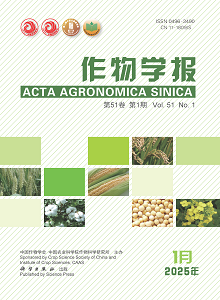Detection of QTLs controlling cold tolerance at bud bursting stage by using a high-density SNP linkage map in japonica rice
引用次数: 1
Abstract
China Abstract: Direct seeded rice (DSR) has received much attention because of its time- and labour-saving and low-input demand. However, the long-term cultivation method of seedling-transplantation has led to loss of some low-temperature-tolerant genes expressed at the bud stage. It has made many currently popular rice varieties unsuitable a recombinant inbred line population constructed by cross of Lijiangxintuanheigu Shennong 265 (SN265) and its linkage map containing 2818 markers to detect cold tolerance QTLs at the bud stage. A total of five QTLs were detected on rice chromosomes 1, 3, 9, and 11. All the cold tolerance alleles were from the cold-tolerant parent LTH. The LOD values of these QTLs ranged from 3.05 to 24.01, and the phenotypic variations ranged from 8.0% to 53.5%. Among them, the major QTL qCTB11b was located in a 790 kb interval of 21.24 Mb to 22.03 Mb on the long arm of chromosome 11. Subsequently, the “selective mapping” strategy was used for QTL verification and pyramiding effect analysis. Genetic improvement of cold tolerance at the bud stage would be achieved through pyramiding more QTLs. These results not only promote people’s understanding of the genetic basis for cold tolerance at the bud stage in rice but also provide theoretical basis and techni-cal guidance for genetic improvement of DSR varieties.利用高密度SNP连锁图谱检测粳稻芽期抗寒性QTL
摘要直播水稻(DSR)因其省时省力、投入少而备受关注。然而,长期的移栽栽培方法导致一些在芽期表达的耐低温基因丢失。利用丽江新团黑谷神农265 (SN265)及其2818个标记的连锁图谱构建的重组自交系群体,对许多目前流行的水稻品种进行了芽期耐寒qtl的检测。在水稻染色体1、3、9和11上共检测到5个qtl。所有耐寒等位基因均来自耐寒亲本LTH。qtl的LOD范围为3.05 ~ 24.01,表型变异范围为8.0% ~ 53.5%。其中,主要QTL qCTB11b位于第11染色体长臂上21.24 ~ 22.03 Mb的790 kb区间。随后,采用“选择性作图”策略进行QTL验证和金字塔效应分析。通过构建更多的qtl,可以实现芽期耐寒性的遗传改良。这些结果不仅促进了人们对水稻芽期耐冷性遗传基础的认识,也为DSR品种的遗传改良提供了理论依据和技术指导。
本文章由计算机程序翻译,如有差异,请以英文原文为准。
求助全文
约1分钟内获得全文
求助全文
来源期刊

作物学报
Agricultural and Biological Sciences-Agronomy and Crop Science
CiteScore
1.70
自引率
0.00%
发文量
89
期刊介绍:
The major aims of AAS are to report the progresses in the disciplines of crop breeding, crop genetics, crop cultivation, crop physiology, ecology, biochemistry, germplasm resources, grain chemistry, grain storage and processing, bio-technology and biomathematics etc. mainly in China and abroad. AAS provides regular columns for Original papers, Reviews, and Research notes. The strict peer-review procedure guarantees the academic level and raises the reputation of the journal. The readership of AAS is for crop science researchers, students of agricultural colleges and universities, and persons with similar academic level.
 求助内容:
求助内容: 应助结果提醒方式:
应助结果提醒方式:


